
|
|

December 14, 2007
Medium Trip '07, Part VII: Waterloo, Iowa
Over the course of 2007, your editor set foot in 20 of our 50 states, visiting broadcast facilities all along the way. And now that the season of travel has ended, it's time to settle back and begin recapping some of what we saw as we criscrossed this land of ours.
This week, we continue our recap of what we'll call "Medium Trip 2007," a 10-day family journey that began and ended in Chicago, taking in much of Iowa and a little of eastern Nebraska along the way, and in the process revisiting for the first time some of the territory from our original Big Trip back in 2001.
When we left off in our last installment, it was Monday afternoon, May 21, and we were zipping north from Des Moines on our way up to a corner of Iowa that we'd already passed through once on this trip.

|
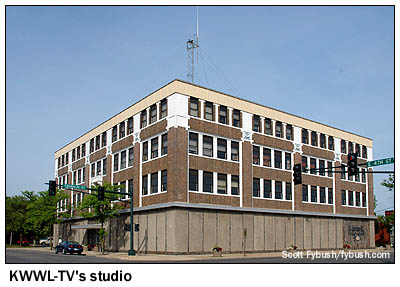
|
We didn't know much about Waterloo and Cedar Falls, Iowa before this year's trip, and our only contact with the community on our first pass through was a quick stop for gas and food on the way up to Mason City near the start of the journey. This time, we had a little more time to spend, starting with Cedar Falls, the college town on the western edge of the metro area. It's home to the University of Northern Iowa, which produced Doug Vernier, one of the top engineering consultants in the public radio arena. We stopped for a visit to his offices (home to v-soft.com and its excellent tool that provides signal strengths for any given zip code in the country), and to see the AM station just down the road. This two-tower array on 1250 was once KCNZ, but then it spawned an expanded-band outlet on 1650 which took the KCNZ calls and formats (now sports as "the Fan 1650"), leaving 1250 as Spanish-language KDNZ. The studios for 1650 and its sister FM, KCVM (96.1 Hudson), remain in the building, as do studios and transmitter for KDNZ.
It's a short drive east along the Cedar River to Waterloo, where we pass the studios of the city's NBC affiliate, KWWL-TV (Channel 7) on the north edge of downtown on our way to Sycamore Street, just a couple of blocks from the river. Here we find the modern studio building that's home to Bahakel Broadcasting's four-station cluster, including the city's big signal, KXEL (1540).
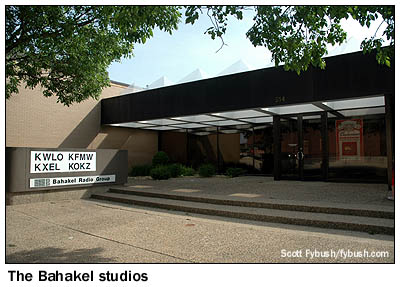
|

|
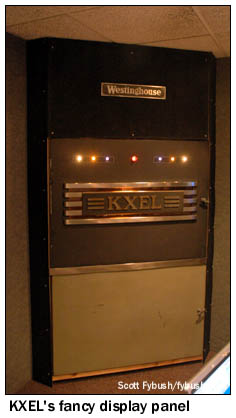 Chief
engineer Mark Schumacher is our tour guide as we head inside,
where the studio cluster lines a hallway along the center of
the building.
Chief
engineer Mark Schumacher is our tour guide as we head inside,
where the studio cluster lines a hallway along the center of
the building.
KXEL, the news-talker in the group, anchors one end of the hallway, with a most unusual object in the corner: one panel of the old Westinghouse HG-50 transmitter that was removed from service has been installed as a display here, complete with the Westinghouse nameplate and the call letters. The lights are purely for show, but it sure does look nifty!
The other AM, "Star 1330" KWLO, runs mostly automated, but a small studio down the hall is used for its live noontime show and production. (Before this signal was KWLO, it was KWWL's AM outlet.)
There are two FMs here, too. KFMW (107.9 Waterloo) is a hard rocker, and its studios have an unusual stand-up configuration with a console mounted in an island in the center of the room. Just down the hall, oldies KOKZ (105.7 Waterloo), the historic FM partner of KXEL, occupies a more conventional studio setup.
There's also an interesting story about how we came into contact with Mark Schumacher here at KXEL, and it all has to do with a nasty ice storm the previous winter that left much of this area without power. KXEL itself was especially hard-hit, losing power at its transmitter site for over a week and shifting its programming over to sister station KWLO in the interim. Somewhere along the way, one of the DX clubs got in contact with Mark to find out what was going on - and he asked if the club contact knew anything about the picture of KXEL's transmitter site that had appeared here on Site of the Week way back in 2001, when we recapped our Big Trip of that year.
Mark took a great deal of pride in the work he'd done since then to upgrade and clean up the transmitter site, and he was hoping it might be possible to get some newer pictures of KXEL up here on Tower Site of the Week - and we, of course, were more than happy to arrange for a visit!
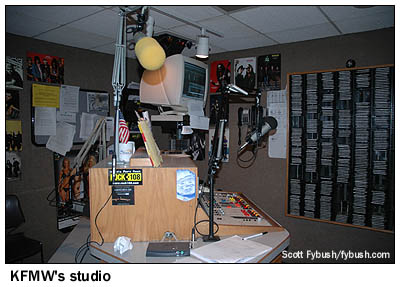
|
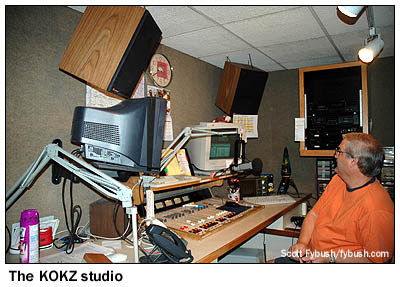
|
As it worked out, our tour of the KXEL transmitter came not on this afternoon, but the following morning, Tuesday, May 22, after a night spent not in Waterloo but in Cedar Rapids, 50 miles to the southeast, for baseball-related reasons we'll explore in detail in next week's Site of the Week.
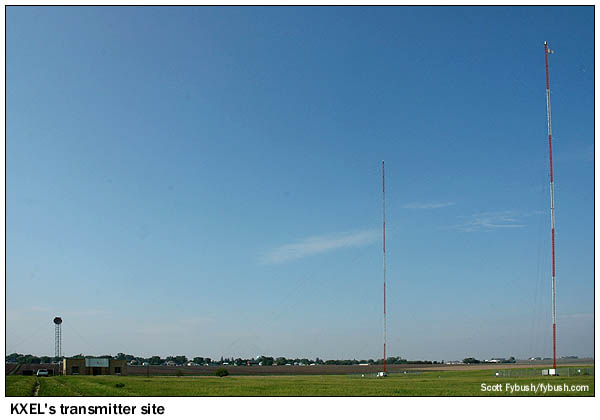
The KXEL transmitter site isn't especially close to either Cedar Rapids or Waterloo. It's in a small town called Dysart, Iowa, about 20 miles south of Waterloo and 30 miles or so northwest of Cedar Rapids. (The trip from Cedar Rapids takes nearly an hour by car, though, thanks to some twisty roads along the way.)
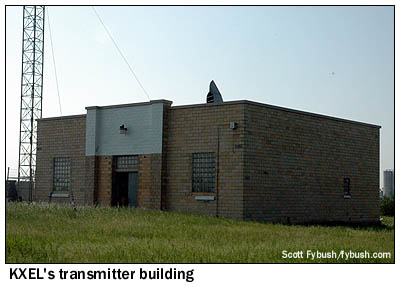
|
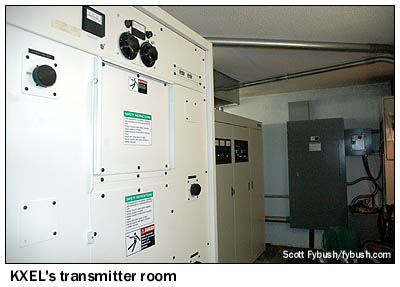
|
These towers aren't all that tall - 275 feet each, plus top-loading - but on 1540 that still creates a 190-degree antenna, which launches a mighty skywave that has no trouble at all reaching me in upstate New York most nights. During the day, when KXEL is running non-directional, it covers most of eastern Iowa, though its signal isn't quite a match for the massive low-dial AMs like WMT or KWMT in the region.
There's an interesting side note here about KXEL: this is one of the few AM stations that was built during World War II. It signed on from the site in Dysart in 1943, and has been here ever since. Inside the transmitter building, there's a big space where the old Westinghouse used to be, and where a Gates VP-50 transmitter succeeded it. That's now mainly storage (indeed, the cabinets for the VP-50, a transmitter we've never seen in operational condition, are tucked back in one corner), and all the action in the building is taking place in a small room just to the left of the front door, where a newer Harris phasor and DX-50 transmitter keep KXEL on the air. (And, yes, there will soon be a generator out here for the next time the power goes out!)
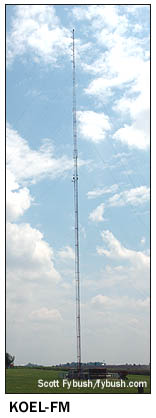
|
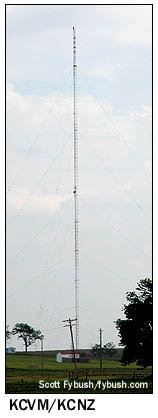
|
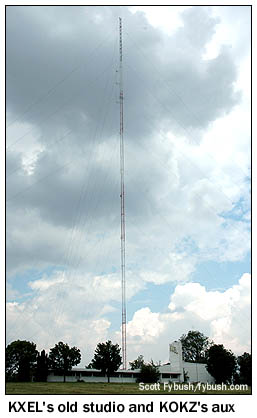
|
One more note from the 2007 ice storm: it took down an FM tower out here. Public radio KHKE (89.5) had its tower off Iowa 21 south of Waterloo (on the way down to Dysart, if one were going that way), and it hadn't yet rebuilt when we were in town in May, instead operating at low power from the University of Northern Iowa campus.
Two other FM towers could still be found south of Waterloo when we came back through the city once more on Tuesday afternoon to finish up our tour. Just south of the US 20 bypass on the southern edge of town sits the stick of KOEL-FM (98.5 Waterloo), and a few miles south of that, off US 63 near Hudson, we find the tower of KCVM (96.1 Hudson) and expanded-band KCNZ (1650 Cedar Falls), whose studios we had seen the previous day.
From here, we circle back on the US 20 bypass to the east side of town, where all of the remaining Waterloo transmitter sites are to be found. First up, on a hill east of Waterloo along Independence Avenue, is the old studio site of KXEL, a building that's now vacant except for an auxiliary transmitter for KOKZ (105.7).
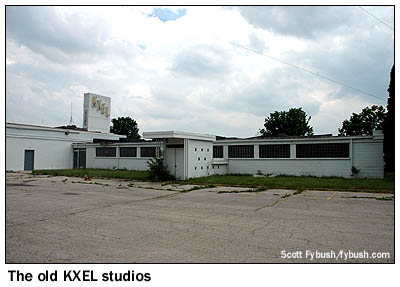
|

|
If this building looks like it might have once been a TV studio, that's almost right - KXEL applied for the channel 7 allocation in the early fifties, apparently with so much confidence that it would win the license that it went right ahead and built a TV studio space. As it turned out, that space would never be used for TV, as the license went to crosstown KWWL instead.
The former KWWL(AM), now KWLO (1330), sits just a mile or so south of the old KXEL studios, with a five-tower in-line array aiming west into town, using two towers by day, five towers at night, and 5000 watts all the time.
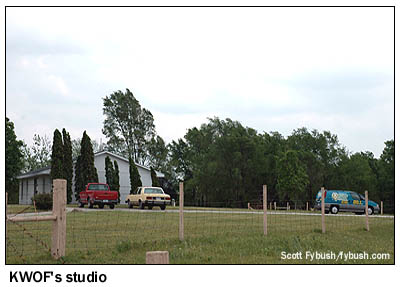
|
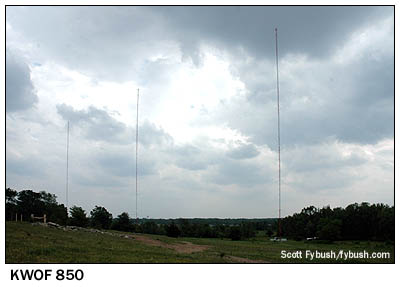
|
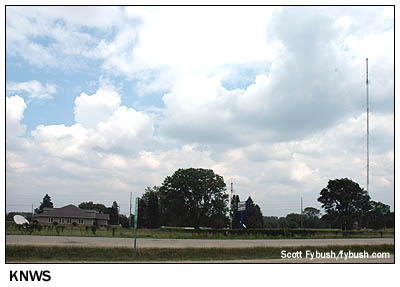 Between
KXEL and KWLO, there's another AM site to be seen. Religious
daytimer KWOF (850) runs 500 watts from these three towers on
Osage Road, with a small studio building right next door.
Between
KXEL and KWLO, there's another AM site to be seen. Religious
daytimer KWOF (850) runs 500 watts from these three towers on
Osage Road, with a small studio building right next door.
When we were last in the area, back in 2001, KWOF was simulcasting on KTOF (1360) down in Cedar Rapids. That AM has since been sold and changed formats and calls (twice, actually), but KWOF now reaches Cedar Rapids with an FM signal, contemporary Christian KWOF-FM (89.1 Hiawatha), which also emanates from these studios east of Waterloo.

 Our
last Waterloo studio/transmitter site is a bit closer in to town,
on Texas Street near the interchange of I-380/US 218 and the
US 20 bypass. Northwestern College's KNWS (1090 Waterloo) is
a non-directional 1000-watt daytimer. Its FM sister, KNWS-FM
(101.9 Waterloo) is a huge 100 kW class C signal that now comes
from the tower of KWWL-TV (Channel 7), a 1999-footer about 20
miles east-southeast of Waterloo in Rowley, Iowa.
Our
last Waterloo studio/transmitter site is a bit closer in to town,
on Texas Street near the interchange of I-380/US 218 and the
US 20 bypass. Northwestern College's KNWS (1090 Waterloo) is
a non-directional 1000-watt daytimer. Its FM sister, KNWS-FM
(101.9 Waterloo) is a huge 100 kW class C signal that now comes
from the tower of KWWL-TV (Channel 7), a 1999-footer about 20
miles east-southeast of Waterloo in Rowley, Iowa.
We didn't have time to go get a very close look at this tower (or at an earlier, shorter KNWS-FM tower nearby), but we snapped a few pictures from US 20 as we drove past, and even from a few miles away, we could make out the KWWL antenna at the top of the mast, the 16-bay KFMW (107.9) antenna just below that, and the 10-bay KNWS-FM antenna below that.
We were on our way east from here to Dyersville - but we've got some other towers to show you before we get there. In next week's installment, we'll backtrack to Cedar Rapids to show you what we were seeing between these Waterloo visits. In the meantime, you can hear nearly all the legal IDs of Waterloo (save for rimshotter KCRR 97.7, which we didn't get somehow), next Wednesday at our sister site, Tophour.com.
Tower Site Calendar 2008 is here! Visit the Fybush.com Store now and get your calendar now!
- Previous Site of the Week: The Medium Trip 2007, part VI: Des Moines' TV/FM Towers, Alleman, IA
- Next Week: Cedar Rapids, IA
- Site of the Week INDEX!
- How can you help support Site of the Week? Click here!
- Submit your suggestions for a future Site of the Week!
